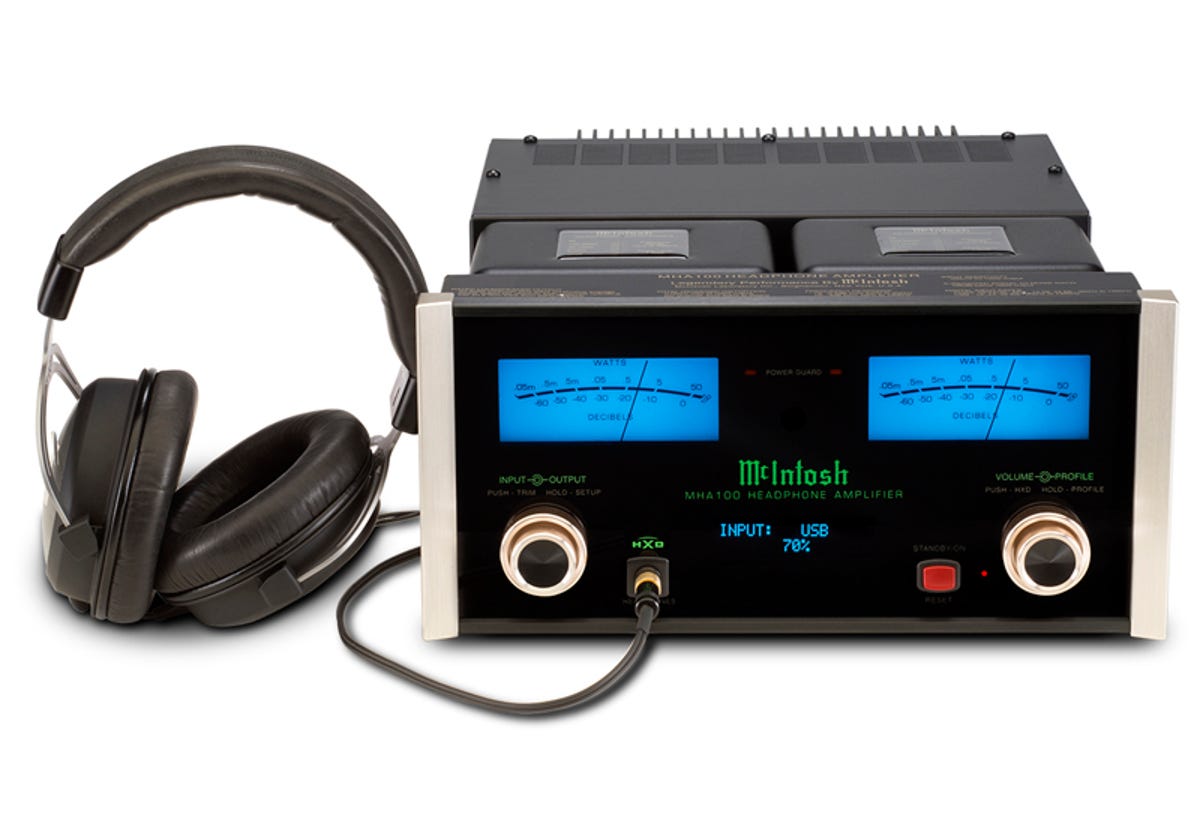
McIntosh
McIntosh is as all-American as high-end audio ever gets. The company was founded in 1949 and has been based in Binghamton, N.Y., for as long as I can remember. McIntosh still designs and builds all of its electronics there. Same as it ever was.
I’ve pestered McIntosh engineers for years about building headphone amplifiers, and all they would ever say was, “We’re working on it.” I was starting to wonder if it would ever happen, and now they’ve done it and the result is called the MHA100. No surprise, it looks exactly like a McIntosh amp for speakers, just smaller: it’s 11.5 x 5.6 x 18 inches (292 x 141 x 457mm), and it weighs 25.5 pounds (12 Kg). That’s huge for a headphone amp! The look and feel are commensurate with the MHA100’s high-end price. I was expecting a tube headphone amp, but it’s a solid-state amp through and through.
Connectivity options include RCA and XLR analog inputs; coaxial, optical, and XLR digital inputs; 6.3mm headphone and stereo speaker binding posts (the MHA100 is also a 50-watt-per-channel stereo amp for speakers). The onboard 24-bit/192-kHz digital converter is the same one used in a lot of McIntosh’s integrated amplifiers.
Related stories
- Being there: The HiFiMan HE-6 headphones
- The Audiophiliac picks 11 of the world’s best headphones (pictures)
- Beyerdynamic T1: Mercedes-Benz of headphones
The MHA100 uses proprietary McIntosh transformer technology to match the amp to the impedance of any headphone. So whether you have very low-impedance 9-ohm Shure SE846 in-ear headphones, or a 600-ohm Beyerdynamic T-1 pair, the MHA100 will bring out the best sound for them, or any headphone. There are also two gain settings, normal and high, to match a variety of headphones.
I started listening to the MHA100 with a pair of HiFiMan HE-6 over-the-ear headphones at the Stereo Exchange high-end audio store in New York. These ‘phones are exceedingly difficult to drive, no smartphone or even home AV receiver can light them up, but here with the MHA100 the HE-6 set was extraordinarily transparent, with lively dynamics and wide-open stereo imaging.
Next, I plugged in another pair of headphones known to humble many an amp, the full-size Beyerdynamic T-1. I’d recently checked out the T-1 with Beyerdynamic’s A-2 headphone amp, but again, the big MHA100 worked its magic. The T-1/MHA100 combination was remarkably pure and clear-sounding, outpacing the superb Audeze LCD-X headphones in that regard.
I also plugged in my Sennheiser IE 800 in-ears (video), which are my everyday headphones I use with my iPod Classic. Wow, the MHA100 transformed their sound. The low bass power and definition were phenomenal, and the stereo imaging was more spacious — I’ve never heard the IE 800 sounding better. I next tried the full-size Sennheiser HD 800 headphones, which have never really turned me on, but the MHA100 sweetened the sound just enough to win me over.
The MHA100 retails for $4,500 in the US, the UK price is £4,995, and it’s AU$6,795 in Australia. That’s really expensive, but I’ve seen 30- and 40-year old McIntosh electronics still in use in countless audiophile systems; the gear is built to last. McIntosh will be introducing a high-end headphone model by the end of the year.



